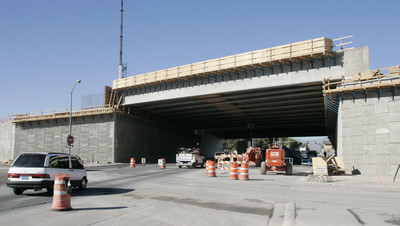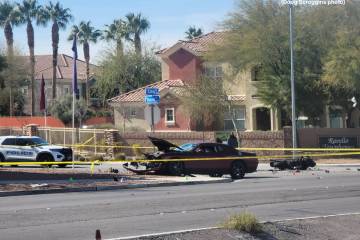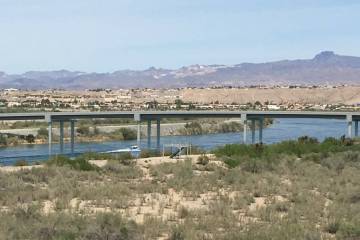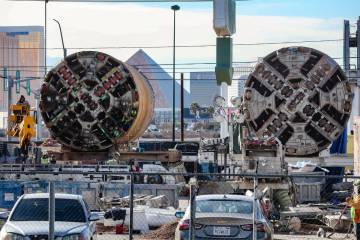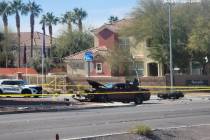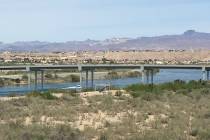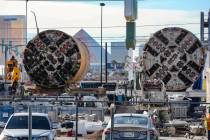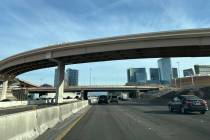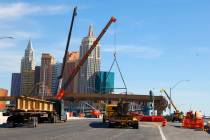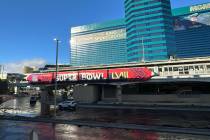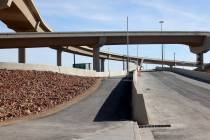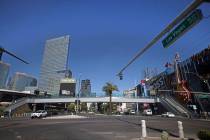I-15 widening project staying ahead of clock
On time? Ahead of schedule?
Perish the thought and knock on wood.
Most Las Vegans probably get sore when they think about Nevada Department of Transportation freeway projects. The decade long construction debacle of U.S. Highway 95 is still too touchy a subject.
But state transportation officials have long held that the $240 million Interstate 15 north widening project would be different because of the method of design and construction.
It's been more than a year since engineers and designers armed with pencils and erasers began the project.
Now state officials are saying the three-year project is on time and may well be completed ahead of schedule.
"I think we're going to beat it (the March 2010 deadline)," Jeff Hale, the project manager for the Transportation Department, told me.
The more than 170,000 motorists who daily traverse the 51/2 miles of heavily congested interstate are probably hoping Hale is right.
The project will widen I-15 from six to 10 lanes from the Spaghetti Bowl to Lake Mead Boulevard, and from four and five lanes to eight lanes from Lake Mead to Craig Road. Interchanges also will be reconstructed at D Street, Lake Mead, Cheyenne Avenue and Craig.
For more than six months, I-15 commuters have been dealing with a number of issues including lower speed limits, longer travel times, lane shifts, lots of cones and fewer lanes. And since July, many commuters have been avoiding the interstate altogether and are clogging surface streets.
Motorists already have seen a major road shift and lane reduction that began in July to allow workers to construct new northbound bridges at D Street, Bonanza Road and Washington Avenue.
And the second round of major changes is on the way.
Hale said the Cheyenne Avenue onramp to southbound I-15 is expected to be opened by Dec. 14, which should relieve pressure on Losee Road.
But the southbound Cheyenne offramp will be closed around the same time.
The Washington onramp to I-15 will be closed beginning Nov. 30, which will affect commuters detouring from U.S. Highway 95 and using Washington via Las Vegas Boulevard to get on northbound I-15. Those motorists will have to travel north to Lake Mead or Cheyenne to get on the interstate.
Also, the Lake Mead interchange will experience similar disruptions now happening on the Craig interchange. The good news is that the Lake Mead interchange will not shut down, unlike the interchanges closer to the Spaghetti Bowl.
And in mid-February, a second major lane shift will take place with the completion of the northbound lanes. Northbound and southbound traffic will be moved to commute over the northbound lanes, while the southbound bridges at Washington, Bonanza and D Street are reconstructed.
"We are aiming for three lanes to be open in each direction by August 2009," Hale said.
It will be another six or seven months before the ramps near the Spaghetti Bowl are open to commuters.
Hale credits the speed of construction to the "design-build" scheme, which overlaps the designing and building phases of a construction project.
In the past, the state has relied on the design-bid-build method, which follows the mantra that a project's design must be completed before a construction firm begins work, with time in between to put the contract out to bid.
The design-build process alone probably saved two years, Hale said.
Since this is the Transportation Department's first foray into the world of design-build projects, there has been a learning curve, Hale said.
For instance, designers had hoped that shutting down cross streets such as Washington and Bonanza wouldn't be necessary.
"We didn't intend on it," Hale said. But the installation of precast girders, which will be the basis for the reconstructed bridges, required the shutdown or a slowdown in construction would occur.
One negative impact has been that the timing of construction coincided with the height of inflation for construction material. The rising costs of asphalt and fuel prices cost an extra $1.5 million, Hale said. The extra cost is being shared by the contractor and the state, he said.
Hale said the sacrifices commuters are making are paying off.
And motorists who routinely use the interstate can readily notice the swiftness of the construction.
Hale is still amazed at the speed of the project.
"We're hoping to be done ahead of schedule," Hale said. "Things are moving very fast."
Knock. Knock. Knock.
If you have a question, tip or tirade, call the Road Warrior at 387-2904, or e-mail him at roadwarrior@reviewjournal.com or fmccabe@reviewjournal.com. Please include your phone number.
The connector ramps from northbound and southbound Interstate 15 and Las Vegas Boulevard, which feed into the westbound Las Vegas Beltway in the southern valley will be closed from 9 tonight to 5 a.m. Monday, the Clark County Public Works Department announced. The overnight ramp closures are necessary as construction crews work to accommodate the widening of this ramp. Motorists are encouraged to use an alternate route such as Russell Road to Decatur Boulevard then south to the Beltway. Casino Center Boulevard has narrowed to one lane for southbound travel between Ogden Avenue and Carson Avenue as part of the ongoing work on the ACE Downtown Connector rapid transit system, the Las Vegas Public Works Department announced. The lane restrictions will continue through November. There will be no northbound travel on this section of Casino Center Boulevard during this time. Main Street, First Street and Las Vegas Boulevard are suggested alternate routes. Also, parking will be permanently eliminated along Casino Center Boulevard between Bridger Avenue and Bonneville Avenue. REVIEW-JOURNAL



